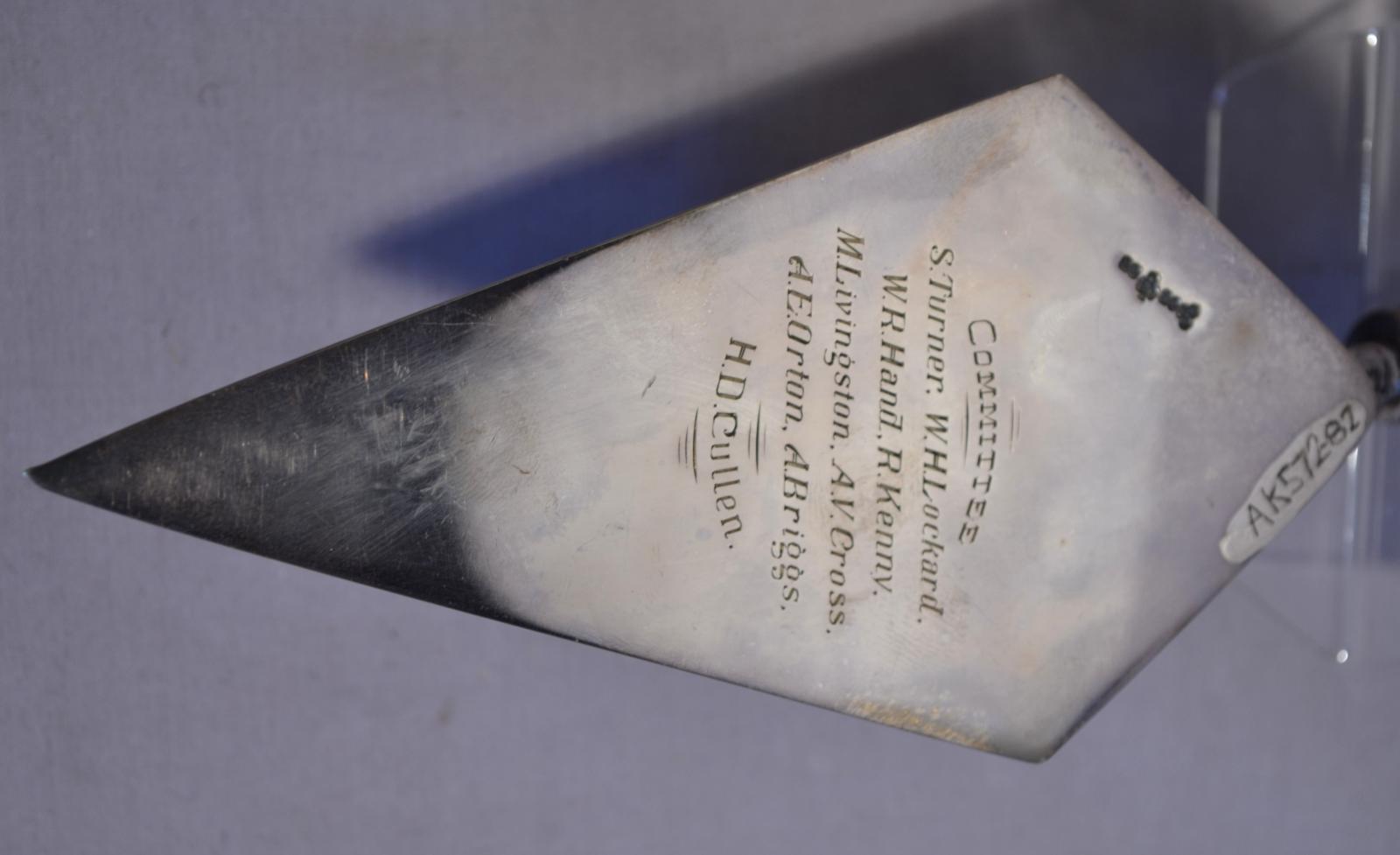Trowel, ceremonial
1916Flat metal four-sided diamond shaped blade with engraved floral decorations at the top of the blade and engraved text on the bottom two thirds of the blade. Top of blade attached to a cylindrical metal neck that slots into a cylindrical handle with a crown like decoration carved onto its end point.
The trowel was presented to Mrs Marian Cullen by members of the Armadale Honour Roll Committee to lay the foundation bricks for the Armadale Role of Honour Obelisk on 12 august 1916. The committee members engraved their names onto the back of the trowel. The names are Samuel Turner, William ‘Bill’ Henry Lockard, Walter Rowland Hand, R. Kenny, M Livingstone, Archibald Vidgen Cross, A.E Orton, Anham Briggs and Herbert Dale Cullen, the husband of Marian.
The event was reported in the Daily News on Monday 14 August 1916 on page 5.
'ERECTING AN OBELISK. — ARMADALE SOLDIERS' MEMORIAL.
A fitting memorial to those residents of the Armadale district who have elected to serve King and Empire is to be erected in that town-ship in the shape of an obelisk in a prominent, position. The structure will be situated on the high ground facing the railway station, and is to be 17ft. in height, and built of specially made bricks, donated by Mr. R. O. Law, of the Armadale Brickworks. To the sides will be attached marble slabs bearing the names, of the heroes. In the presence of a number of residents of the district, and several prominent citizens, including, the Commandant (Colonel Courtney), the, Minister for Works (Mr. W. J. George), and Mr. Nainv M.L.A. the official brick-laying' ceremony, was enacted on Saturday afternoon. The chairman of the committee in charge of the project (Mr. Turner) explained its significance, and mentioned that the generosity of the whole of the inhabitants of the district had enabled the committee to achieve what had been done. Mrs. H. Dale Cullen, wife of the secretary of the committee, performed the ceremony, of laying the official foundation brick, and was presented by the committee with a handsome trowel as a memento of the occasion.
Representatives of each of the five schools in the district then laid bricks, and brought forward donations from their schoolmates. Congratulations to the district were extended by Colonel Courtney, who mentioned that the inhabitants had done their share, and more than their share, in the work of the Empire. Mr. George expressed pleasure at being present, and remarked that the people of Armadale were beginning to think of their men, not merely as so many units across the seas, but as persons belonging to them, and fighting their battles. Mr. Nairn, M.L.A., also extended congratulations. Souvenirs were presented to a number of soldiers who have recently en-listed by the vice-president of the local Soldiers' Welcome Home Committee (Mrs. James). The plans for the obelisk have been prepared gratuitously by Mr. H. Boas and the work of carting has been honorary. About half the funds required had been secured up to Saturday, and following on the ceremony persons were permitted to lay bricks at a charge of 5s each. A sale of produce for the purpose of obtaining funds was conducted by Mr. Lantzke. A block of land, presented by Mr. F. J. Shaw will be disposed of by Art Union, and the proceeds handed over to the committee.'
In 1916 Armadale residents formed a ‘Roll of Honour’ committee with the aim of constructing an obelisk at the intersection of Fourth Road and Eleventh Avenue.
The design for the Obelisk was drawn up by Perth architect and town planner Harold Boas. The memorial would represent the soldiers and nurses from Armadale, West Armadale, Beenup (Byford), Wungong and Bedfordale. Kelmscott, Roleystone and Karragullen planned to construct their own memorial.
Marian Cullen, wife of the Armadale Honour Roll Committee secretary, was given the honour of laying the first brick. Bricks were also laid by a student from the five local schools. The memorial was built using locally made bricks on a granite base with white marble tablets. On 16 December 1916 Governor Sir Harry Barron unveiled the obelisk.
In 1959 the obelisk was moved to Fallen Soldiers Memorial Park out of fear of it being damaged by traffic using the intersection where it was located. Two new marble panel were added during its relocation. The first listed the names of the 21 men who had lost their lived in World War II. The second was for Private Gerald Russel, who was killed in 1953 while serving in the Korean War.
In the 1990s the Obelisk received a facelift with the original marble panels removed and replaced with new black stone panels. In 2019 following an extensive research project these panels were replaced with new white marble panels featuring a far more comprehensive list of the local men and women who had enlisted in World War I.
Details
Details
Front [AUG.12.1916. / Presented to / Mrs H DALE CULLEN / on her laying the / FOUNDATION STONE / OF THE / Armadale / Roll of Honour / Obelisk]
Back [COMMITTEE / S. Turner, W.H. Lockard, / W.R. Hand, R. Kenny, / M. Livingston, A.V. Cross, / A.E. Orton, A Briggs, / H.D. Cullen.]
Open in Google Maps
Nearest geotagged records:
- OBELISK STONE - TO THE MEMORY OF THE MEN (0km away)
- SHOEING PINCERS (0.23km away)
- DOUBLE ENDED RING SPANNER (0.23km away)
- ADJUSTABLE SPANNER (0.23km away)
- HOOKED FLAT BAR LEVER (0.23km away)
- COLD CHISEL (0.24km away)
- PARROT PINCERS (0.24km away)
- STEEL WEDGE (0.24km away)
- AUGER (0.24km away)
- JACK PLANE (0.24km away)
Nearby places: View all geotagged records »
City of Armadale - History House
City of Armadale - History House
Other items from City of Armadale - History House

Scan this QR code to open this page on your phone ->
